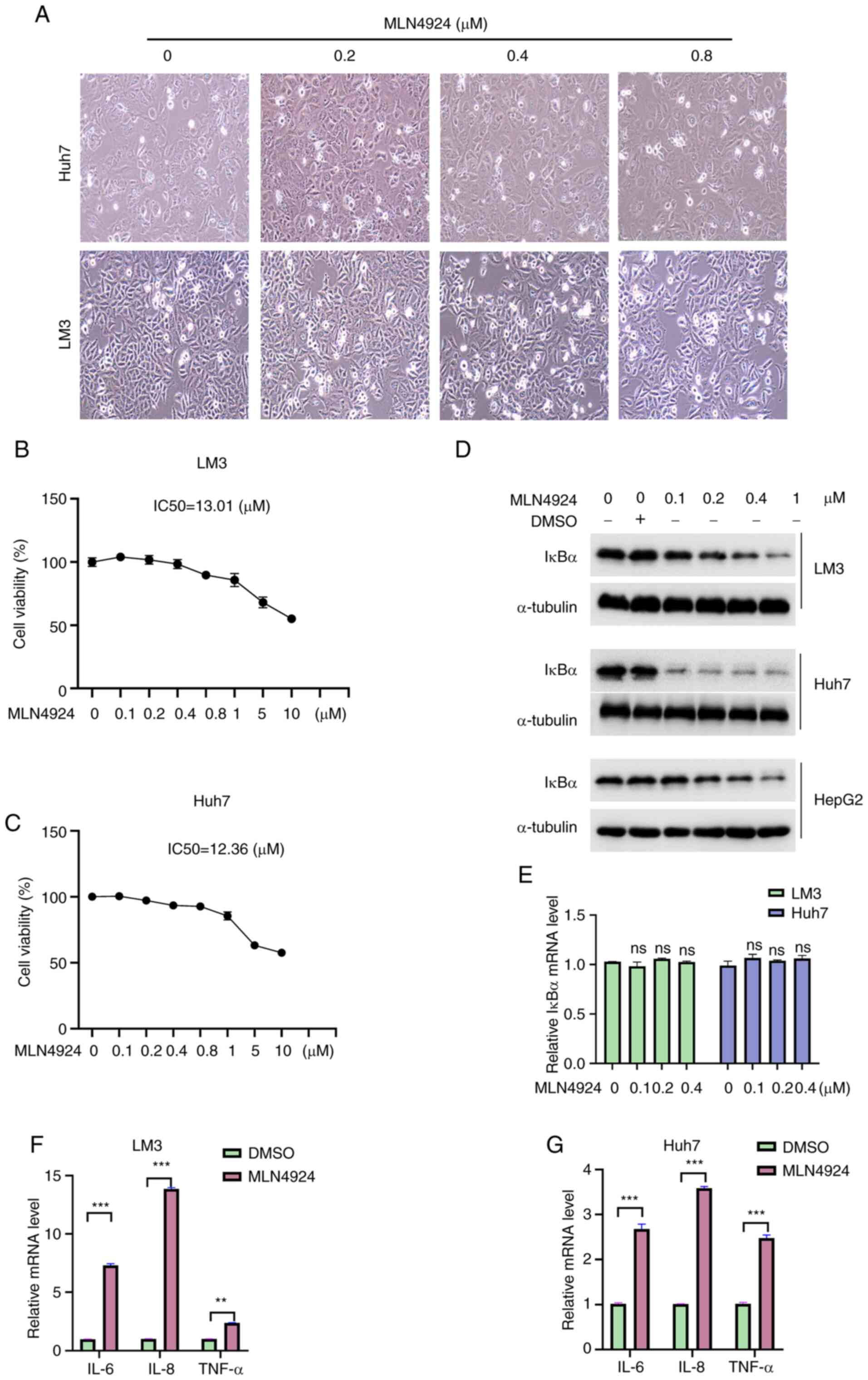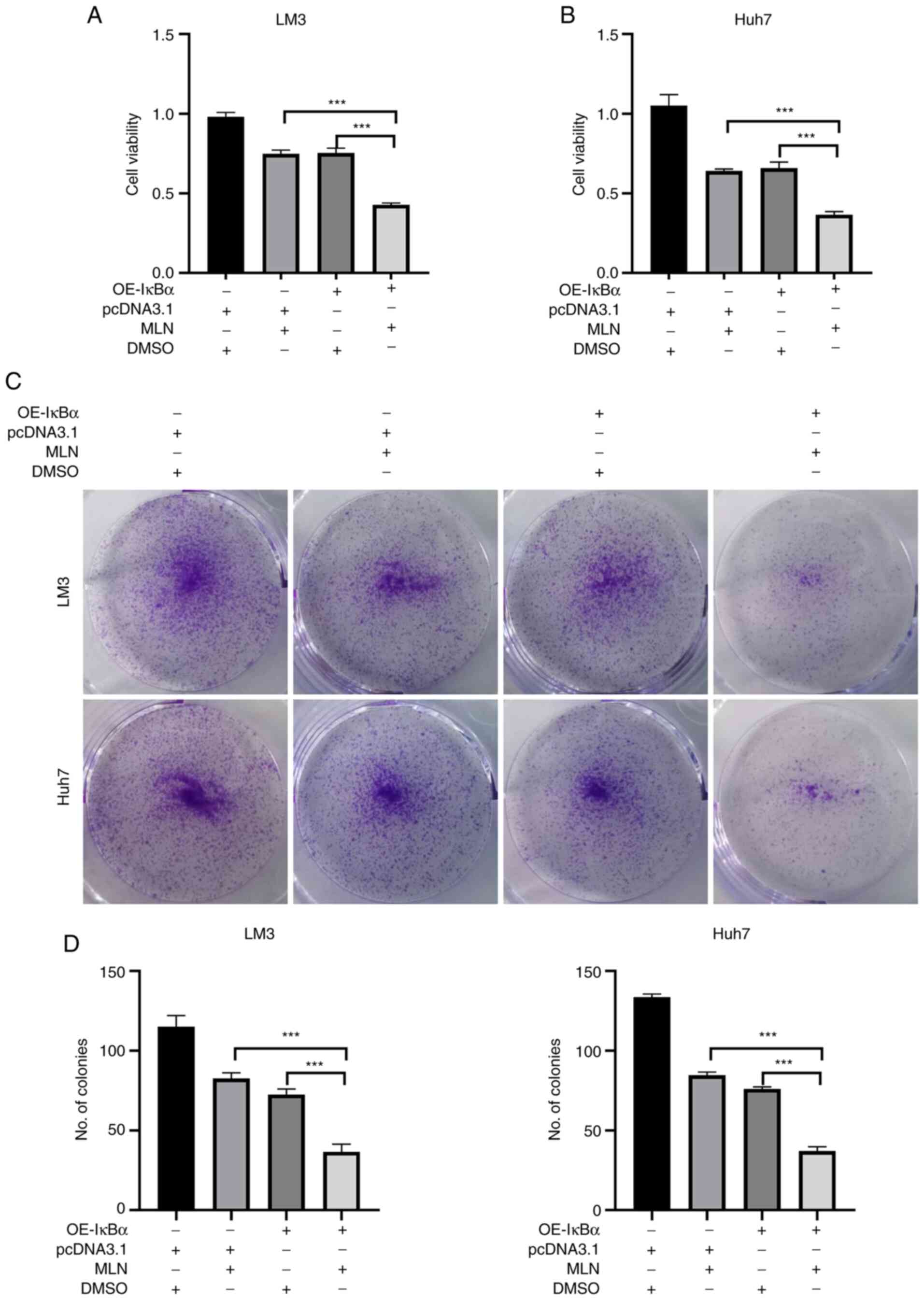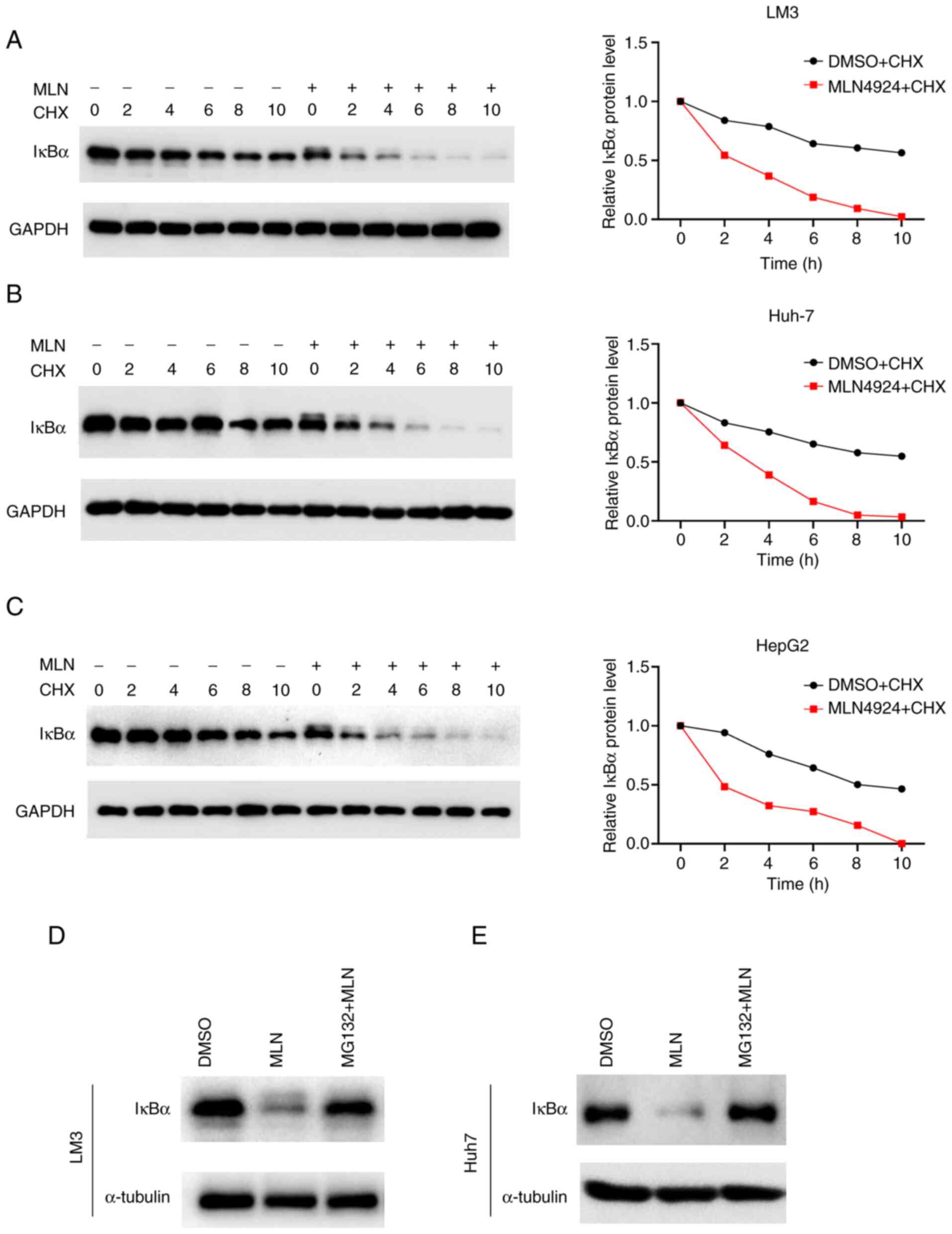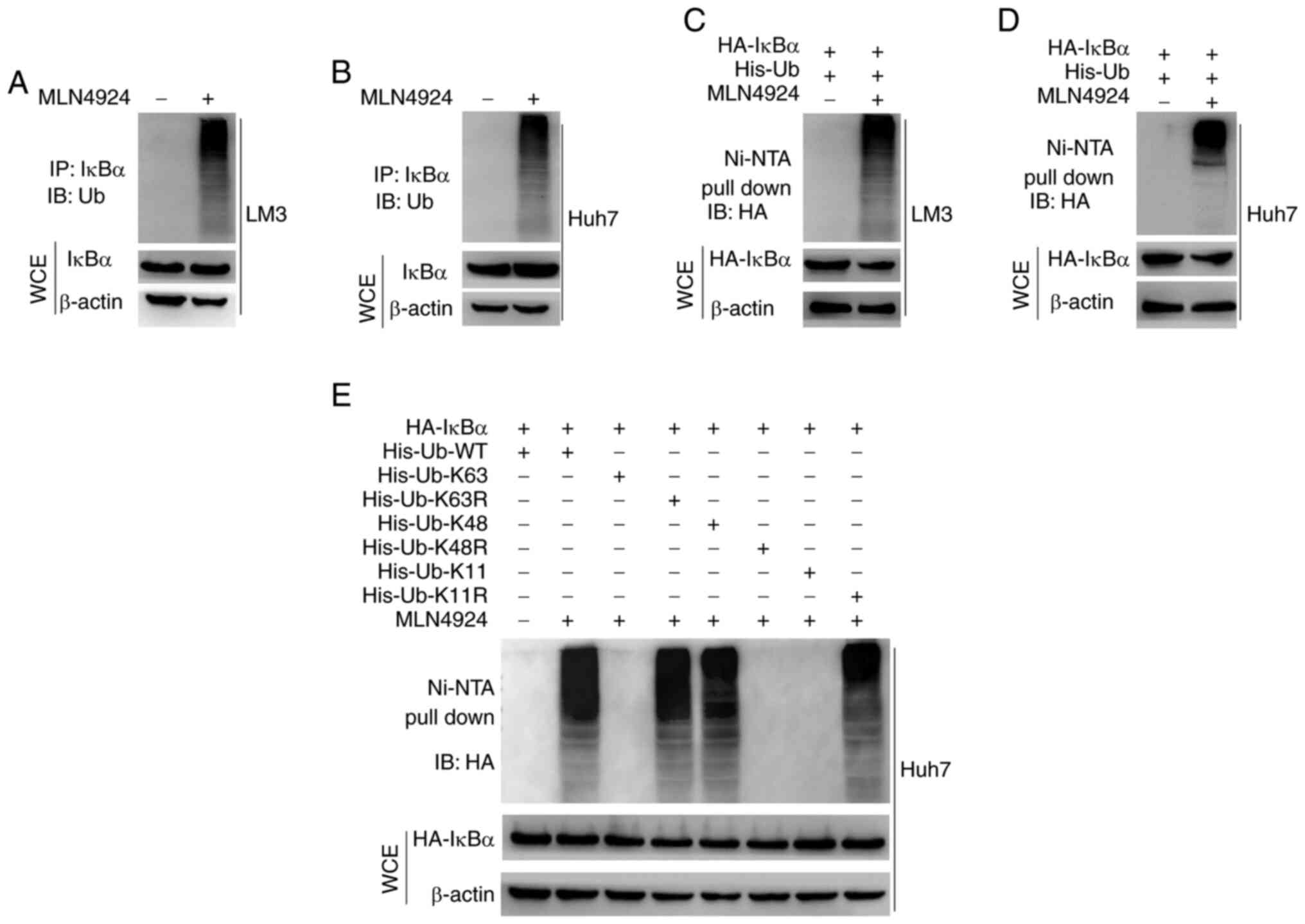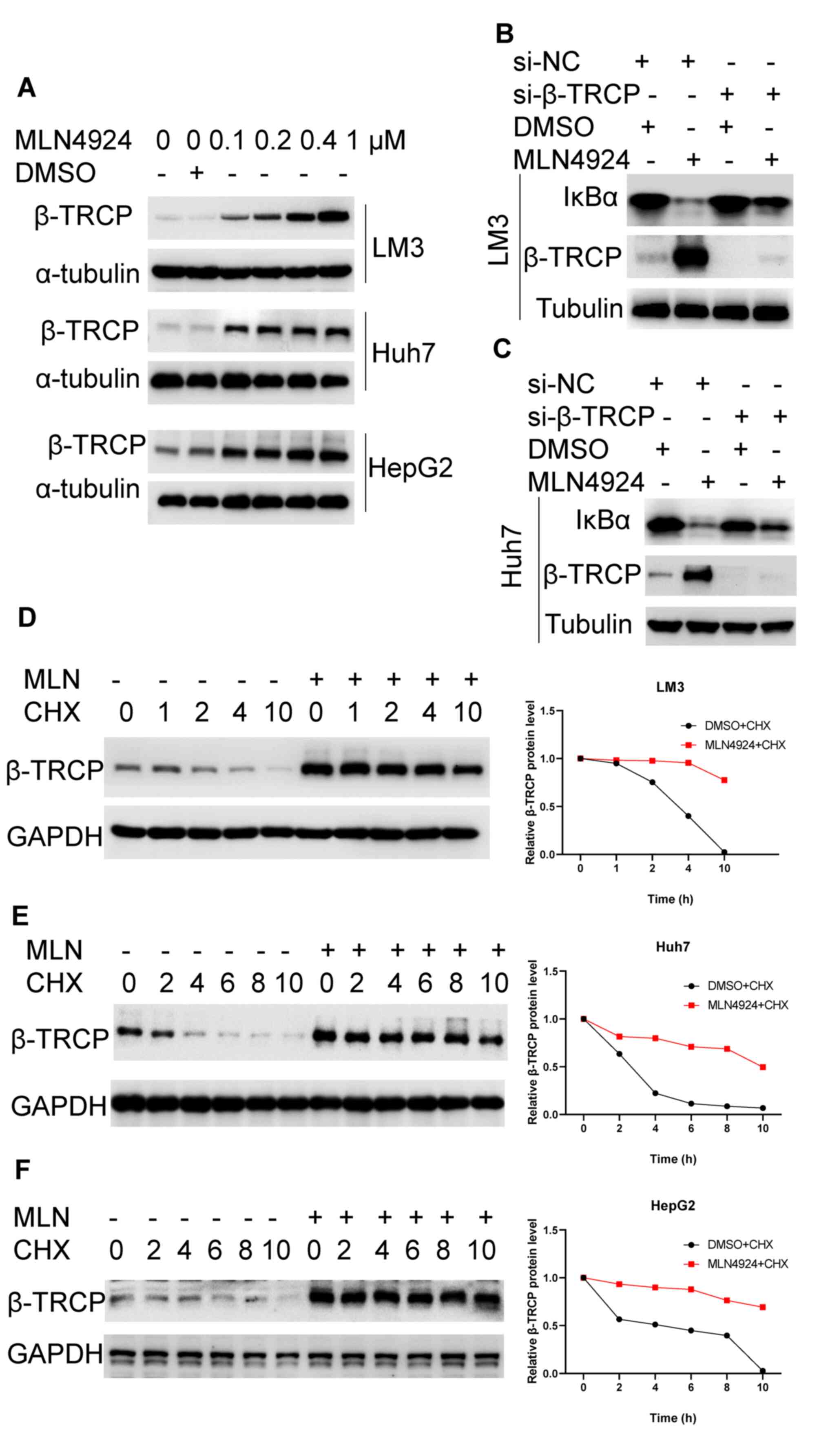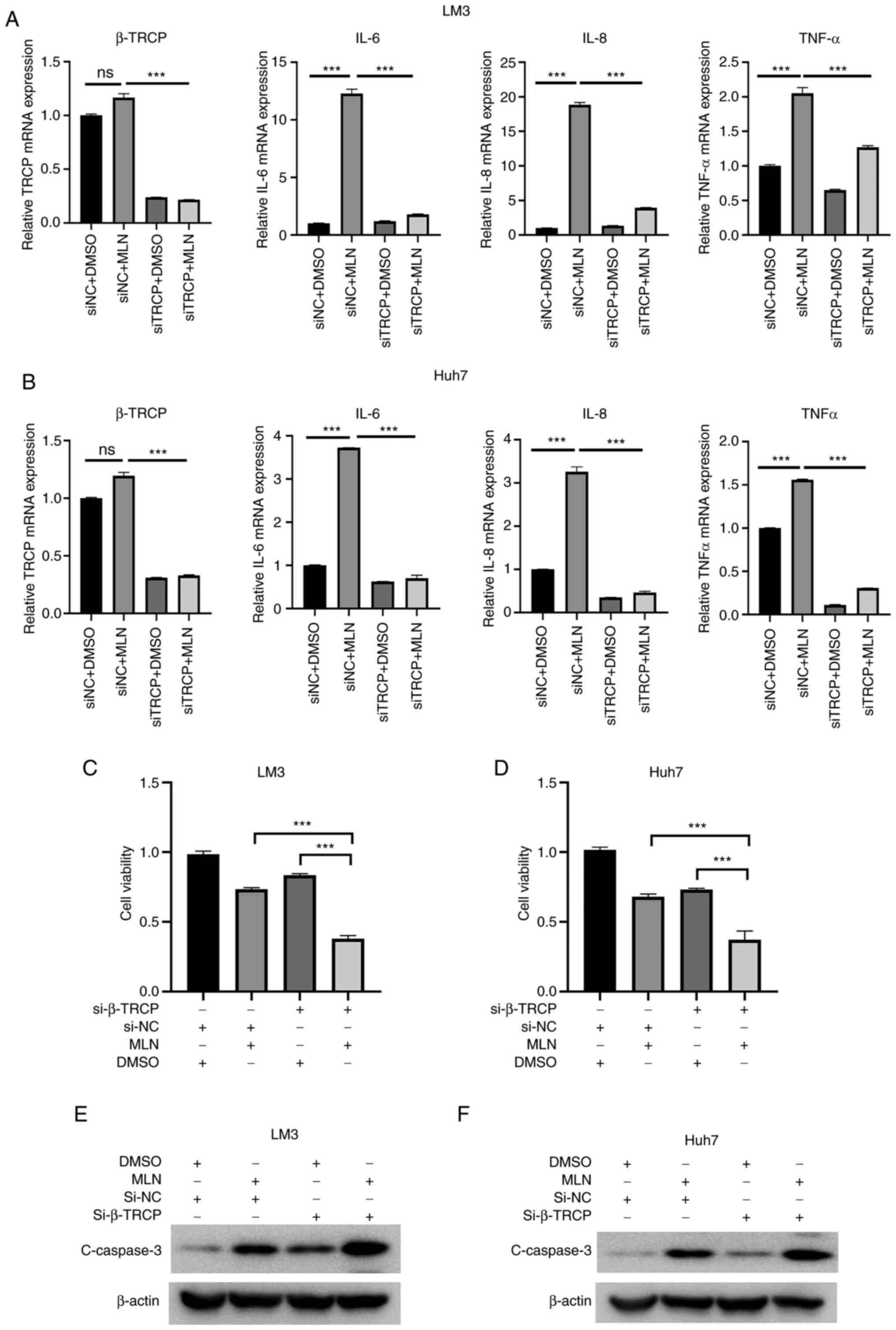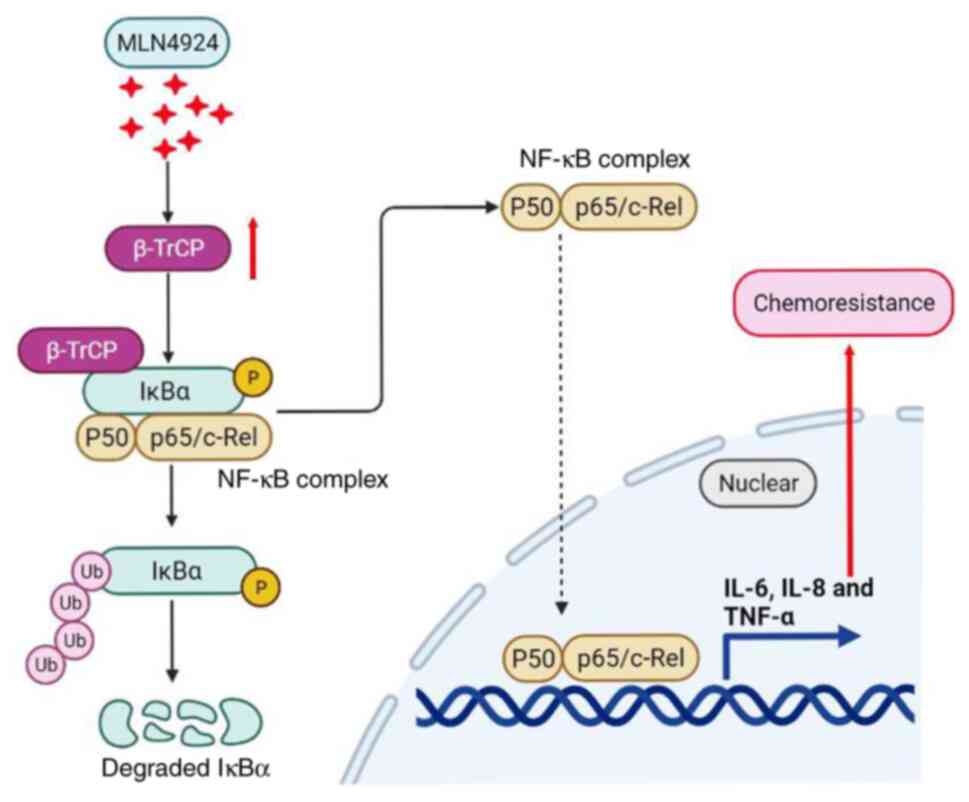Activation of the β‑TrCP/IκBα/inflammation axis limits the sensitivity of liver cancer cells to neddylation inhibition
- Authors:
- Published online on: September 27, 2022 https://doi.org/10.3892/or.2022.8416
- Article Number: 201
-
Copyright: © Xiong et al. This is an open access article distributed under the terms of Creative Commons Attribution License.
Abstract
Introduction
Hepatocellular carcinoma (HCC) accounts for ~80% of primary liver cancers and is the third leading cause of cancer-related mortality worldwide (1,2). In patients with early-stage liver cancer, surgery resection and thermal ablation are the most common available treatment options (3,4). However, the majority of patients with liver cancer are diagnosed at an advanced stage, and are therefore unlikely to respond to these treatment options due to the rapid development and distant metastases of HCC (5). Over the past decade, treatment options for HCC have progressed and include multi-kinase inhibitors (sorafenib and lenvatinib) and immune checkpoint inhibitors. However, treatment of advanced HCC remains unsatisfactory, as the overall survival rates of patients with liver cancer are marginally extended following treatment (6). Therefore, further investigations are required for the development of novel potential therapies for liver cancer including HCC.
Protein neddylation is an important post-translational modification that adds the ubiquitin-like molecule NEDD8 to substrate proteins (7). This is carried out via a series of processes that are successively catalyzed by E1 NEDD8-activating enzyme (NAE1), E2 neddylation conjugation enzymes and E3 neddylation ligases. Previous studies have demonstrated that neddylation regulates protein function and stabilization. Well-established substrates of the neddylation pathway are the Cullin family of proteins that are the scaffold components of cullin-RING ligases (CRLs). Neddylation of Cullin is indispensable for the activation of CRLs and the subsequent ubiquitination and degradation of CRL substrates (8). Results of a previous study revealed that protein neddylation is upregulated in numerous human cancers, including liver cancer, and inhibition of neddylation exhibits anticancer potential (9).
MLN4924, also known as pevonedistat, is a specific inhibitor of NAE. MLN4924 suppresses the entire protein neddylation modification (10). Results of a previous study demonstrated that MLN4924 exhibits suppressive activity against a variety of human cancer cells. Moreover, MLN4924 has been advanced into several Phase II/III clinical trials against solid tumors and hematologic malignancies (11–14). Mechanistic studies that focus on the role of MLN4924 in cancer suppression revealed that MLN4924 effectively induced the DNA damage response, nonhomologous end-joining repair, DNA re-replication stress and oxidative stress at the biochemical level, and induced cell cycle arrest, apoptosis, autophagy and senescence at the cellular level (15). However, results of a previous study demonstrated that the anticancer effects of MLN4924, particularly in solid tumors, remain unsatisfactory due to drug resistance (16). This factor limits the clinical use of MLN4924; thus, exploring the mechanisms of drug resistance of cancer cells to MLN4924 may help overcome chemoresistance and improve the associated clinical outcomes.
Chemoresistance is a major obstacle to curing cancer. Previous research has demonstrated that inflammation is an important factor that attenuates the chemosensitivity of cancer cells to anticancer agents. For example, doxorubicin activates the NF-κB signaling pathway, resulting in transactivation of inflammatory factors and potent anti-apoptosis genes, which leads to the chemoresistance of cancer cells (17). In addition, multiple previous studies have demonstrated that the NF-κB signaling pathway is aberrantly activated in multiple cancer types, such as HCC (18), cervical cancer (19) and lung cancer (20), providing a rationale for overcoming chemoresistance by targeting the NF-κB pathway. Notably, NF-κB inhibitor α (IκBα), the upstream molecule of NF-κB, plays an important role by inhibiting NF-κB activity (21). In the resting state, IκBα combines with the NF-κB dimer to retain its existence in the cytoplasm. On the other hand, IκBα is triggered by diverse extracellular signals in the activating state, such as lipopolysaccharide, tumor necrosis factor (TNF) and growth factors. Subsequently, IκBα is phosphorylated by the IκB kinase complex and recognized by an E3 ubiquitin ligase for ubiquitination-dependent degradation (21). Moreover, IκBα is considered a tumor-suppressing factor in different types of cancer, such as breast (22), ovarian (23), gastric (24), colorectal (25) and liver cancer (26), mainly due to its inhibition of NF-κB activity. However, it remains unclear whether the levels of IκBα can be regulated by MLN4924 in liver cancer cells.
Results of the present study demonstrated that downregulation of IκBα and the subsequent inflammation in response to MLN4924 limits the antitumor potential of MLN4924 in liver cancer cells. Mechanistic studies revealed that MLN4924 stabilized β-transducin repeat-containing protein (β-TrCP), promoting the K48 linkage of ubiquitin to the IκBα protein, leading to the degradation of IκBα via proteasomes. In addition, β-TrCP knockdown sensitized liver cancer cells to MLN4924. Collectively, the results of the present study revealed that the β-TrCP/IκBα/inflammation axis limited the sensitivity of liver cancer cells to neddylation inhibition, suggesting that interference of this pathway may act as a novel target for developing new sensitizing strategies of MLN4924 to liver cancer treatment.
Materials and methods
Reagents
MLN4924 and MG132 (a proteasome inhibitor) were purchased from Selleck Chemicals. Opti-MEM was purchased from Invitrogen (Thermo Fisher Scientific, Inc.). Cycloheximide (CHX) was purchased from Chengdu XiYa Chemical Technology Co., Ltd. RNAiso Plus reagent, SYBR Green Mix and Reverse Transcription kit were purchased from Takara Bio, Inc. X-tremeGENE HP DNA Transfection Reagent, X-tremeGENE siRNA Transfection Reagent and Cocktail were purchased from Roche Diagnostics, GmbH. Cell Counting Kit-8 (CCK-8) was purchased from Dojindo Laboratories, Inc. Small interfering (si)RNAs targeting β-TrCP and control siRNA were synthesized by Shanghai GenePharma Co., Ltd.
Cell lines and culture
The human liver cancer cell line LM3 was purchased from BeNa Culture Collection (cat. no. BNCC342335), the HepG2 cell line (cat. no. HB-8065) was obtained from the American Type Culture Collection and the Huh7 cell line (cat. no. SCSP-526) was purchased from the National Collection of Authenticated Cell Cultures of the Chinese Academy of Sciences (https://www.cellbank.org.cn/). All cells were cultured in DMEM containing 10% fetal bovine serum at 37°C in a 5% CO2 incubator.
Plasmid construction
The DNA fragment encoding IκBα (NM_020529) was synthesized by Shanghai GeneChem Co., Ltd., and inserted into the vector pcDNA-3.1. The resulting plasmid was named pcDNA-IκBα or overexpression (OE)-IκBα. The His-ub (His-ubiquitin) plasmids and the corresponding mutant plasmids were constructed by Tsingke Biotechnology Co., Ltd.
Reverse transcription-quantitative (RT-q)PCR
Total RNA was isolated from cultured cells using RNAiso Plus reagent, and the first-strand cDNA was synthesized using the PrimeScript RT Reagent Kit with gDNA Eraser (Takara Bio, Inc.) according to the manufacturer's instructions. qPCR was performed using a One-Step RT-PCR kit (ComWin) and SYBR Green Mix. The PCR cycle parameters were as follows: 95°C for 30 sec, and 40 cycles at 95°C for 5 sec and 60°C for 1 min. Results were calculated based on the quantification cycle (Cq), and the relative fold change was determined using the 2−ΔΔCq method (27). Primers used for RT-qPCR are listed as follows: IL-6-forward (F), 5′-TACCCCCAGGAGAAGATTCC-3′ and IL-6-reverse (R), 5′-TTTTCTGCCAGTGCCTCTTT-3′; IL-8-F, 5′-CGGAAGGAACCATCTCACTGTG-3′ and IL-8R, 5′-AGAAATCAGGAAGGCTGCCAAG-3′; TNF-α-F, 5′-AACCTCCTCTCTGCCATCAA-3′ and TNF-α-R, 5′-CCAAAGTAGACCTGCCCAGA-3′; β-TrCP-F, 5′-CAGTTCTGCACTTGCGTTTC-3′ and β-TrCP-R, 5′-CTCACTACCAGCCTGTCCCT-3′; IκBα-F, 5′-AAGTGATCCGCCAGGTGAAG-3′ and IκBα-R, 5′-CTGCTCACAGGCAAGGTGTA-3′; and β-actin-F, 5′-GTGAAGGTGACAGCAGTCGGTT-3′ and β-actin-R, 5′-GAAGTGGGGTGGCTTTTAGGA-3′.
Transient transfection
Liver cancer cells were seeded and cultured in 6-well plates overnight at 37°C in an incubator, and small interfering RNAs (siRNAs, 100 pmol) or plasmids (2 µg) were transfected into liver cancer cells using X-tremeGENE siRNA Transfection Reagent or X-tremeGENE HP DNA Transfection Reagent for 48 h in 37°C incubator, respectively, according to the manufacturer's instructions. The sequences of siRNAs are listed as follows: si-β-TrCP (100 pmol), 5′-AAGUGGAAUUUGUGGAACAUC-3′ and si-negative control (si-NC; 100 pmol), 5′-UUCUCCGAACGUGUCACGUTT-3′.
MG132 treatment protocol
Following treatment with MLN4924 for 48 h, LM3 and Huh7 cells were incubated with or without 20 µM MG132 for 5 h at 37°C. Subsequently, western blotting was employed to determine the protein levels of IκBα.
Western blot analysis
Cells were lysed with RIPA lysis buffer (Beyotime Institute of Biotechnology) supplemented with a protease inhibitor mixture (Roche Diagnostics), and then the lysates were centrifuged at 16,000 × g for 15 min at 4°C. The protein concentrations were then detected using a BCA kit (Beyotime Institute of Biotechnology), according to the manufacturer's instructions. Following denaturing, samples (100 µg/lane) were separated by 10% SDS-PAGE (Beyotime Institute of Biotechnology) and then transferred to NC membranes (Cytiva). The NC membranes were then blocked in 5% nonfat milk in Tris-buffered saline containing 0.1% Tween-20 (TBST) for 1 h at room temperature and then incubated with the indicated primary antibodies. Primary antibodies against ubiquitin (cat. no. sc-271289; 1:1,000 dilution), β-TrCP (cat. no. sc-390629; 1:1,000 dilution) and IκBα (cat. no. sc-373893; 1:1,000 dilution) were purchased from Santa Cruz Biotechnology, Inc. Anti-cleaved caspase-3 was purchased from Cell Signaling Technology (product no. 9664; 1:1,000 dilution). Primary antibodies against GAPDH (cat. no. AG019; 1:5,000 dilution) and tubulin (cat. no. AT819; 1:5,000 dilution) were purchased from Beyotime Institute of Biotechnology. All primary antibodies were incubated at 4°C overnight. Secondary antibodies, HRP-labeled goat anti-rabbit (cat. no. 7074S) and anti-mouse (cat. no. 7076S) immunoglobulin G, were purchased from Cell Signaling Technology, Inc. The secondary antibodies were diluted in 5% skim milk at a ratio of 1:5,000 and incubated at room temperature for 1 h, and then the protein signals were measured using chemiluminescence detection reagent (cat. no. WBKLS0500; Millipore; Merck KGaA) and the Bio-Rad Imaging System (Image Lab 4.1; Bio-Rad Laboratories, Inc.).
Immunoprecipitation (IP)
Liver cancer cells were lysed using IP lysis buffer purchased from Beyotime Institute of Biotechnology, and then the lysates were centrifuged at 10,000 × g for 10 min at 4°C. Subsequently, the supernatant was collected into another EP tube. The anti-IκBα antibody (cat. no. sc-373893) was then added to the lysate in a ratio of 2:1 mg total protein. Following overnight incubation at 4°C, 40 ml protein A/G agarose beads (Santa Cruz Biotechnology, Inc.) were added to each sample and incubated at room temperature for 2 h. The immunoprecipitates were washed five times with ice-cold PBS and isolated by centrifugation (600 × g, 3 min, 4°C). Finally, the precipitates were mixed with 1X SDS-PAGE loading buffer and boiled at 100°C for 10 min, and then assessed by western blot analysis.
In vitro ubiquitination assay
To examine the ubiquitination of IκBα by MLN4924, liver cancer cells were co-transfected with His-ub (His-ubiquitin) and HA-IκBα, and subsequently incubated with MLN4924 (0.4 µM) for 48 h at 37°C. MG132 (20 µM) was added to the medium for 5 h, cells were harvested and subsequently split into two aliquots; one for direct western blotting and one for in vitro ubiquitination. Briefly, cells were lysed in buffer A [6 mol/l guanidinium-HCl, 0.1 mol/l Na2HPO4/NaH2PO4, 10 mmol/l Tris-HCl (pH 8.0), 5 mmol/l imidazole and 10 mmol/l β-mercaptoethanol] on ice, sonicated to reduce viscosity and mixed with 50 µl Ni2+-NTA-agarose beads (Qiagen, Inc.) overnight. Beads were successively washed with buffer A with 10 mM β-mercaptoethanol, buffer B [8 mM urea, 0.1 M Na2HPO4/NaH2PO4, 10 mM Tris/HCl (pH, 8.0), and 10 mM β-mercaptoethanol], buffer C [8 mM urea, 0.1 M Na2HPO4/NaH2PO4, 10 mM Tris/HCl (pH, 6.3), 10 mM β-mercaptoethanol and 0.2% Triton X-100], and buffer C with 10 mM β-mercaptoethanol and 0.1% Triton X-100. Subsequently, His6-tagged ubiquitinated proteins were eluted with buffer D [200 mM imidazole, 0.15 M Tris-HCl (pH, 6.7), 30% glycerol, 0.72 M β-mercaptoethanol and 5% SDS]. The polyubiquitination of IκBα was detected using western blot analysis, using an anti-HA antibody (cat. no. 11867423001, 1:5,000; Roche Diagnostics).
Cell proliferation assays
Liver cancer cells were seeded in 96-well plates at 3,000 cells per well overnight at 37°C, and transiently transfected with the indicated plasmids or siRNAs, and then incubated with MLN4924 for 48 h. Subsequently, the CCK-8 agent was added to each well at a volume of 10 µl per well, and then incubated at 37°C for 30–60 min, followed by detection of the absorption value at 450 nm with a microplate reader (Thermo Scientific, Inc.).
Colony formation assays
Liver cancer cells were seeded in 6-well plates at 500 cells per well overnight at 37°C, and transiently transfected with the indicated plasmids or siRNAs or incubated with MLN4924 (0.4 µM) for 10 days. Subsequently, the cells were fixed with 4% formaldehyde (15 min at room temperature) and stained with 0.1% crystal violet at room temperature for 10 min. During colony growth, the culture medium was replaced every 3 days. Colonies with >50 cells were counted manually, 10–14 days after plating.
Bioinformatics analysis
UALCAN and GEPIA online databases were utilized to determine the mRNA level of IκBα (NFKBIA). Briefly, NFKBIA was selected after logging in the website (UALCAN, http://ualcan.path.uab.edu/analysis.html). Subsequently, liver hepatocellular carcinoma (LIHC) was selected as the subject of analysis. Thereafter, the button ‘Explore’ was selected and the result for the expression of NFKBIA in LIHC based on sample tapes was obtained. For the usage of GEPIA online database (|Log2FC| Cutoff: 1; P-value Cutoff: 0.01), NFKBIA was typed into the box under ‘Enter gene/isoform name’ after logging in the website (GEPIA, http://gepia2.cancer-pku.cn/#index), and then the ‘Boxplots’ button was selected followed by LIHC. Thereafter, the button ‘Plot’ was selected and the result of the mRNA level of NFKBIA in 160 normal liver tissues and 369 liver cancer tissues was obtained. For the analysis of the protein level of IκBα in different human cancers and corresponding normal tissues, Clinical Proteomic Tumor Analysis Consortium (CPTAC, http://ualcan.path.uab.edu/analysis-prot.html) online database was employed. NFKBIA was typed into the box under ‘Enter gene names’ column after logging in the website, and then LIHC was selected, followed by the analysis of the protein level of NFKBIA between normal and liver cancer tissues. For the analysis of normal and primary cancer of pan-cancer, the ‘Pan-cancer view’ link was selected. Z-values represent standard deviations from the median across samples for the given cancer type in analyzing the protein level of IκBα.
Statistical analysis
GraphPad Prism 8.0 (GraphPad Software, Inc.) was used to analyze data. Data are presented as the mean ± standard deviation. Comparisons between two groups were performed using a two-tailed unpaired Student's t-test. Comparisons between multiple groups were performed using one-way ANOVA, followed by Tukey's post hoc test. The data are presented as the mean ± SD of at least three independent experiments. P<0.05 was considered to indicate a statistically significant difference.
Results
MLN4924 suppresses the survival of liver cancer cells and downregulates IκBα
A previous study demonstrated that MLN4924 exhibits antitumor potential (28). To confirm this phenomenon, the effects of MLN4924 on the growth of liver cancer cells were investigated in the present study. As revealed in Fig. 1A, 0.8 µM MLN4924 increased the natant cells compared with the control group, while 0.4 µM MLN4924 exhibited no notable effect on cell morphology (Fig. 1A). Therefore, this concentration (0.4 µM) of MLN4924 was selected to investigate the chemoresistance of liver cancer cells in the subsequent experiments. Moreover, the results of the CCK-8 assay demonstrated that MLN4924 suppressed the growth of liver cancer cells in a dose-dependent manner. However, the half maximal inhibitory concentration (IC50) values of MLN4924 in LM3 and Huh7 cells were 13.01 and 12.36 µM, respectively (Fig. 1B and C), indicating that MLN4924 markedly suppressed the growth of liver cancer cells at high concentrations. As IκBα is considered a tumor-suppressing factor in various cancers due to its inhibition of NF-κB activity, the expression levels of IκBα in cancer tissues were further investigated using bioinformatics analysis. The results obtained from the UALCAN database demonstrated that the IκBα mRNA expression levels exhibited no significant difference between 50 healthy liver tissues and 371 LIHC tissues (Fig. S1A). These results were further confirmed using an alternative database, GEPIA, containing 160 healthy liver tissues and 369 HCC tissues (Fig. S1B). Notably, protein expression analysis using data from the Clinical Proteomic Tumor Analysis Consortium (CPTAC) revealed that the IκBα protein expression levels were markedly reduced in HCC (Fig. S1C), ovarian cancer, uterine corpus endometrial carcinoma and lung adenocarcinoma (Fig. S1D). These results suggested that the regulation of IκBα during liver carcinogenesis and development may occur at a post-translational level. Subsequently, the effects of MLN4924 on IκBα expression were explored. As shown in Fig. 1D and E, MLN4924 significantly decreased IκBα protein expression levels in a dose-dependent manner; however, it exerted no effect on the mRNA expression. Furthermore, it was determined whether MLN4924 inhibited the protein level of IκBα in a time-dependent manner. As revealed in Fig. S2, the protein level of IκBα was markedly decreased following treatment with MLN4924 for 48 and 72 h, and thus 48 h was selected in the subsequent experiments. As IκBα plays a key role in anti-inflammation (29), mRNA expression levels of interleukin (IL)-6, IL-8 and TNF-α, downstream molecules of IκBα, were explored in the present study. As shown in Fig. 1F and G, MLN4924 significantly increased the mRNA expression levels of IL-6, IL-8 and TNF-α. Collectively, these findings indicated that MLN4924 possesses an antitumor role in liver cancer cells; however, decreased IκBα expression may impact its antitumor potential.
IκBα overexpression sensitizes MLN4924 to inhibit liver cancer cells
To clarify whether MLN4924-induced IκBα downregulation is involved in the insensitivity of liver cancer cells to MLN4924 treatment, LM3 and Huh7 cells were treated with MLN4924 in the presence or absence of OE-IκBα. Firstly, the efficacy of the plasmid transfection (OE-IκBα) was determined using qPCR and it was determined that the mRNA level of IκBα was significantly increased after transfection with OE-IκBα plasmid, suggesting that transfection with OE-IκBα successfully overexpressed IκBα in both LM3 and Huh7 cells (Fig. S3). As revealed in Fig. 2A and B, cotreatment with MLN4924 and OE-IκBα significantly suppressed the growth of liver cancer cells compared with MLN4924 or OE-IκBα treatment alone. Moreover, the results of the colony formation assay revealed that cotreatment with MLN4924 and OE-IκBα significantly inhibited the number of colonies, compared with MLN4924 or OE-IκBα treatment alone (Fig. 2C and D). These results indicated that downregulation of IκBα is a novel resistance factor of MLN4924, and overexpression of IκBα sensitizes MLN4924 to inhibit liver cancer cells.
MLN4924 decreases the protein stability of IκBα
The mechanism by which MLN4924 decreases the expression of IκBα was explored in the present study. The results of the RT-qPCR analysis revealed that IκBα mRNA expression levels exhibited no significant change following MLN4924 treatment (Fig. 1E), suggesting that MLN4924 downregulated IκBα at a post-translational level. Thus, IκBα protein stability was determined following the addition of CHX in the presence or absence of MLN4924. As demonstrated in Fig. 3A-C, MLN4924 treatment markedly decreased the protein stability of IκBα and reduced the half-life of IκBα protein in LM3, Huh7 and HepG2 cells. The results of previous research demonstrated that proteasomes play an important role in protein degradation (30). To verify whether the proteasome is involved in MLN4924-mediated IκBα degradation, the proteasome inhibitor MG132 was utilized. A previous study demonstrated that MG132 (20 µM) always exerts its function to inhibit protein degradation at 4–6 h (31), thus, MG132 (20 µM) was added and incubated with LM3 and Huh7 cells at 37°C for 5 h before harvesting. As shown in Fig. 3D and E, MG132 treatment markedly attenuated MLN4924-induced IκBα downregulation. These results indicated that MLN4924 promoted IκBα protein degradation via a proteasome-associated pathway.
MLN4924 promotes the K48 linkage of ubiquitin to IκBα protein
A previous study demonstrated that the ubiquitin–proteasome pathway is key in controlling the degradation of proteins in eukaryocytes (30). Thus, the role of MLN4924 in IκBα protein degradation via the ubiquitin-proteasome pathway was explored. As revealed in Fig. 4A and B, MLN4924 markedly enhanced the ubiquitination of endogenous IκBα, and this was further confirmed using exogenous overexpression of IκBα (Fig. 4C and D). These results indicated that MLN4924 promoted the polyubiquitination of IκBα protein. To determine the type of ubiquitin chains involved in MLN4924-mediated IκBα polyubiquitination, six ubiquitin mutants (K63, K63R, K48, K48R, K11 and K11R) were used along with the wild-type (WT) ubiquitin. Results of the in vitro ubiquitination assay indicated that K63 and K11 ubiquitin mutants attenuated the formation of the polyubiquitin chain to IκBα, compared with the K48 ubiquitin mutant and WT ubiquitin. Moreover, the results of the present study demonstrated that the K48R ubiquitin mutant significantly attenuated the formation of the polyubiquitin chain to IκBα, compared with WT, and the K63R and K11R mutant forms of ubiquitin (Fig. 4E). Collectively, these results indicated that MLN4924 promoted the K48-linked ubiquitination of IκBα.
MLN4924 promotes the degradation of IκBα protein via stabilizing β-TrCP
The mechanism underlying MLN4924-induced degradation of IκBα was further explored in the present study. The results of a previous study demonstrated that β-TrCP, also named FBXW1, is an important E3 ligase for the ubiquitin-proteasome pathway-dependent degradation of IκBα (32). Thus, the role of MLN4924 in IκBα degradation via β-TrCP was explored. The results of the western blot analysis demonstrated that MLN4924 markedly enhanced the protein expression levels of β-TrCP in LM3, Huh7 and HepG2 cells compared with the controls (Fig. 5A). In addition, LM3 and Huh7 cells were transfected with si-β-TrCP or si-NC in the presence or absence of MLN4924. As shown in Fig. 5B and C, β-TrCP knockdown markedly reduced MLN4924-mediated IκBα downregulation. These results indicated that MLN4924 promoted the degradation of IκBα via upregulation of β-TrCP. Moreover, the protein stability of β-TrCP was evaluated by adding translation inhibitor CHX in the presence or absence of MLN4924. The results of the present study demonstrated that MLN4924 significantly enhanced the protein stability of β-TrCP and prolonged the half-life of β-TrCP in LM3, Huh7 and HepG2 cells (Fig. 5D-F). Collectively, these results indicated that MLN4924 induces the degradation of IκBα via stablizing β-TrCP.
β-TrCP knockdown enhances the antitumor potential of MLN4924 in liver cancer cells via inhibiting inflammation
To clarify whether knockdown of β-TrCP enhanced the antitumor potential of MLN4924 in liver cancer cells via inhibiting inflammation, LM3 and Huh7 cells were treated with MLN4924 in the presence or absence of si-β-TrCP. As revealed in Fig. 6A and B, transfection with si-β-TrCP significantly reduced the mRNA expression of β-TrCP. Moreover, MLN4924 treatment notably enhanced the mRNA expression levels of IL-6, IL-8 and TNF-α, which was significantly attenuated following β-TrCP knockdown in LM3 and Huh7 cells. Moreover, the results of the CCK-8 assay demonstrated that cotreatment with si-β-TrCP and MLN4924 significantly suppressed the growth of liver cancer cells, compared with MLN4924 or si-β-TrCP treatment alone (Fig. 6C and D). In addition, the results of the western blot analysis demonstrated that β-TrCP knockdown markedly enhanced MLN4924-induced caspase-3 upregulation compared with the controls (Fig. 6E and F). Collectively, these results demonstrated that β-TrCP knockdown enhanced the antitumor potential of MLN4924 in liver cancer cells via inhibiting inflammation.
Discussion
The results of a previous study (28) demonstrated that MLN4924 exhibits high suppressive activity against a variety of human cancer cells. However, further investigations into the specific mechanisms underlying MLN4924 as an anticancer treatment are required. To the best of our knowledge, the results of the present study were the first to demonstrate that downregulation of IκBα and subsequent inflammation is key for attenuating the antitumor potential of MLN4924 in liver cancer cells. The mechanistic study of MLN4924-induced IκBα downregulation revealed that MLN4924 stabilized β-TrCP, promoting the ubiquitination of IκBα; thus, enhancing the degradation of IκBα and subsequent inflammation. This therefore attenuated the antitumor potential of MLN4924 in liver cancer cells. Moreover, the results of the present study demonstrated that β-TrCP knockdown enhanced the antitumor potential of MLN4924 in liver cancer cells via inhibiting inflammation. Collectively, the afore mentioned results may provide a novel potential strategy for sensitizing MLN4924 in the treatment of liver cancer.
The results of previous studies have demonstrated that inflammation could lead to chemoresistance of cancer cells (17,33). Zhong et al revealed that the NF-κB-IL6-STAT3 axis activated by intratumoral LPS promoted the expression of cyclin D1, c-Myc, Bcl-2 and survivin, facilitating prostate cancer proliferation and docetaxel chemoresistance (33). Neddylation-inhibitor MLN4924 exhibits broad anticancer potential and may be used as a chemotherapeutic agent in the future. However, it remains to be fully elucidated whether inflammation is involved in the chemoresistance of liver cancer cells in response to MLN4924 treatment. The results of the present study demonstrated that MLN4924 promoted IκBα degradation and increased the expression of inflammatory factors (IL-6, IL-8 and TNF-α), leading to the chemoresistance of liver cancer cells to MLN4924. Notably, the results of a previous study demonstrated that MLN4924 inhibited activation of the NF-κB pathway via inhibiting CRL-mediated IκBα degradation. However, the results of this study did not indicate that treatment with MLN4924 decreased the protein expression levels of IκBα (34). Moreover, IκBα knockdown significantly increased the MLN4924-mediated proliferation inhibition in esophageal cancer cells (34). Therefore, the contrasting results of the two studies may be ascribed to the different cancer cell lines, as liver cancer is one of several cancers that is often associated with chronic inflammation.
MLN4924, a neddylation inhibitor, suppresses CRLs via inhibiting NAE-mediated cullin neddylation (28). Notably, the results of the present study demonstrated that MLN4924 promoted the proteasome-dependent degradation of IκBα and shortened the half-life of IκBα, following treatment with MG132 and translation inhibitor CHX. Moreover, the K48-linkage of ubiquitin to IκBα was significantly increased following treatment with MLN4924, which reflects that some E3 ligases may be involved in MLN4924-mediated IκBα degradation. The expression of β-TrCP, a well-established E3 ligase for IκBα degradation (35), was markedly increased following MLN4924 treatment in liver cancer cells. However, the molecular mechanism by which MLN4924 stabilizes β-TrCP remains unclear. Further studies are warranted to clarify which protein is targeted by MLN4924 directly and participates in the regulation of β-TrCP stability. Moreover, in the present study it was determined that MLN4924 promoted IκBα degradation via stabilizing β-TrCP, despite a previous study which reported that β-TrCP is inhibited by MLN4924 (36). Therefore, it was hypothesized that increase of β-TrCP may be a resistance response of liver cancer cells when treated with neddylation inhibitor MLN4924.
β-TrCP acts as a substrate receptor and constitutes an active SCFβ−TrCP ligase with a scaffold protein cullin 1 (CUL1), a RING protein RBX1 and an adaptor protein SKP1 (37). β-TrCP plays a critical role in the regulation of various physiological and pathological processes, including signal transduction, cell cycle progression, cell migration, DNA damage response and tumorigenesis, by governing large amounts of key regulators for ubiquitination and proteasomal degradation (38). The results of previous studies have demonstrated that β-TrCP plays a vital role in carcinogenesis via promoting the degradation of its substrates, including oncoproteins and tumor suppressors (38). Specifically, the results of previous studies demonstrated that β-TrCP is upregulated in liver cancer tissues (39,40). Previous research has also demonstrated that β-TrCP promotes HCC progression and metastasis via degrading leucine zipper tumor suppressor 2 (LZTS2) in HCC cells (41). These results indicated that β-TrCP acts as an oncoprotein in liver cancer, which provides clear rationale for targeting β-TrCP to overcome chemoresistance. The results of the present study demonstrated that β-TrCP was increased following MLN4924 treatment, and β-TrCP knockdown enhanced the antitumor potential of MLN4924 in liver cancer cells. Moreover, MLN4924 enhanced the protein expression levels of β-TrCP via inhibiting its degradation and prolonging its half-life. However, the mechanism by which MLN4924 stabilizes β-TrCP remains to be fully elucidated. Previous investigations demonstrated that β-TrCP1 is ubiquitinated and degraded by SCFSKP2 ubiquitin ligase, SAG-CUL5 ubiquitin ligase with UBCH10 and UBE2S E2s, as well as the SMURF2:UBCH5 complex (38). Moreover, members of the de-ubiquitinating enzyme (DUB) family, such as USP24 (42) and USP47 (43,44), enhance the stability of β-TrCP. Further investigations into the role of E3 ligases and DUBs in MLN4924-mediated β-TrCP upregulation are required.
In conclusion, the results of the present study demonstrated that downregulation of IκBα and the subsequent inflammation attenuate the antitumor potential of MLN4924 in liver cancer cells. Mechanistic studies demonstrated that MLN4924 enhanced the protein stability of β-TrCP, promoting the ubiquitination of IκBα protein, leading to the ubiquitin–mediated degradation of the IκBα protein, which is summarized in a working diagram (Fig. 7). In addition, the results of the present study demonstrated that β-TrCP knockdown markedly sensitized MLN4924 in suppressing the growth of liver cancer cells via attenuating MLN4924-mediated IκBα downregulation and inflammation. The results of the present study not only provide novel insights into the molecular mechanisms by which MLN4924 promotes the degradation of IκBα and subsequent inflammation, but also offer a potential therapeutic strategy for sensitizing MLN4924 in the treatment of liver cancer.
Supplementary Material
Supporting Data
Acknowledgements
Not applicable.
Funding
Funding: No funding was received.
Availability of data and materials
The datasets used and/or analyzed during the present study are available from the corresponding author on reasonable request.
Authors' contributions
ZhixiangY and ZhenzhouY supervised the present study. HX designed the research, performed the experiments and drafted the manuscript. HX, DZ, YL and LMa contributed to the acquisition of data. HX, DZ and YL analyzed and interpreted the data. HX, YL, LMa and LMeng performed the statistical analysis. HX and ZhixiangY confirm the authenticity of all the raw data. All authors have read and approved the final manuscript.
Ethics approval and consent to participate
Not applicable.
Patient consent for publication
Not applicable.
Competing interests
The authors declare that they have no competing interests.
References
|
Sung H, Ferlay J, Siegel RL, Laversanne M, Soerjomataram I, Jemal A and Bray F: Global cancer statistics 2020: GLOBOCAN estimates of incidence and mortality worldwide for 36 cancers in 185 countries. CA Cancer J Clin. 71:209–249. 2021. View Article : Google Scholar : PubMed/NCBI | |
|
Bray F, Ferlay J, Soerjomataram I, Siegel RL, Torre LA and Jemal A: Global cancer statistics 2018: GLOBOCAN estimates of incidence and mortality worldwide for 36 cancers in 185 countries. CA Cancer J Clin. 68:394–424. 2018. View Article : Google Scholar : PubMed/NCBI | |
|
Forner A, Reig M and Bruix J: Hepatocellular carcinoma. Lancet. 391:1301–1314. 2018. View Article : Google Scholar : PubMed/NCBI | |
|
Forner A, Llovet JM and Bruix J: Hepatocellular carcinoma. Lancet. 379:1245–1255. 2012. View Article : Google Scholar : PubMed/NCBI | |
|
Llovet JM, Zucman-Rossi J, Pikarsky E, Sangro B, Schwartz M, Sherman M and Gores G: Hepatocellular carcinoma. Nat Rev Dis Primers. 2:160182016. View Article : Google Scholar : PubMed/NCBI | |
|
Llovet JM, Kelley RK, Villanueva A, Singal AG, Pikarsky E, Roayaie S, Lencioni R, Koike K, Zucman-Rossi J and Finn RS: Hepatocellular carcinoma. Nat Rev Dis Primers. 7:62021. View Article : Google Scholar : PubMed/NCBI | |
|
Enchev RI, Schulman BA and Peter M: Protein neddylation: Beyond cullin-RING ligases. Nat Rev Mol Cell Biol. 16:30–44. 2015. View Article : Google Scholar : PubMed/NCBI | |
|
Yu Q, Jiang Y and Sun Y: Anticancer drug discovery by targeting cullin neddylation. Acta Pharm Sin B. 10:746–765. 2020. View Article : Google Scholar : PubMed/NCBI | |
|
Zhou L, Zhang W, Sun Y and Jia L: Protein neddylation and its alterations in human cancers for targeted therapy. Cell Signal. 44:92–102. 2018. View Article : Google Scholar : PubMed/NCBI | |
|
Soucy TA, Smith PG, Milhollen MA, Berger AJ, Gavin JM, Adhikari S, Brownell JE, Burke KE, Cardin DP, Critchley S, et al: An inhibitor of NEDD8-activating enzyme as a new approach to treat cancer. Nature. 458:732–736. 2009. View Article : Google Scholar : PubMed/NCBI | |
|
Luo Z, Yu G, Lee HW, Li L, Wang L, Yang D, Pan Y, Ding C, Qian J, Wu L, et al: The Nedd8-activating enzyme inhibitor MLN4924 induces autophagy and apoptosis to suppress liver cancer cell growth. Cancer Res. 72:3360–3371. 2012. View Article : Google Scholar : PubMed/NCBI | |
|
Soucy TA, Dick LR, Smith PG, Milhollen MA and Brownell JE: The NEDD8 conjugation pathway and its relevance in cancer biology and therapy. Genes Cancer. 1:708–716. 2010. View Article : Google Scholar : PubMed/NCBI | |
|
Milhollen MA, Traore T, Adams-Duffy J, Thomas MP, Berger AJ, Dang L, Dick LR, Garnsey JJ, Koenig E, Langston SP, et al: MLN4924, a NEDD8-activating enzyme inhibitor, is active in diffuse large B-cell lymphoma models: Rationale for treatment of NF-{kappa}B-dependent lymphoma. Blood. 116:1515–1523. 2010. View Article : Google Scholar : PubMed/NCBI | |
|
Sarantopoulos J, Shapiro GI, Cohen RB, Clark JW, Kauh JS, Weiss GJ, Cleary JM, Mahalingam D, Pickard MD, Faessel HM, et al: Phase I study of the investigational NEDD8-activating enzyme inhibitor pevonedistat (TAK-924/MLN4924) in patients with advanced solid tumors. Clin Cancer Res. 22:847–857. 2016. View Article : Google Scholar : PubMed/NCBI | |
|
Zhou Q, Li H, Li Y, Tan M, Fan S, Cao C, Meng F, Zhu L, Zhao L, Guan MX, et al: Inhibiting neddylation modification alters mitochondrial morphology and reprograms energy metabolism in cancer cells. JCI Insight. 4:e1215822019. View Article : Google Scholar : PubMed/NCBI | |
|
Ferdosi SR, Taylor B, Lee M, Tang N, Peng S, Bybee R, Reid G, Hartman L, Garcia-Mansfield K, Sharma R, et al: PTEN loss drives resistance to the neddylation inhibitor MLN4924 in glioblastoma and can be overcome with TOP2A inhibitors. Neuro Oncol. 19:noac0672022. View Article : Google Scholar | |
|
Taniguchi K and Karin M: NF-κB, inflammation, immunity and cancer: Coming of age. Nat Rev Immunol. 18:309–324. 2018. View Article : Google Scholar : PubMed/NCBI | |
|
Elsharkawy AM and Mann DA: Nuclear factor-kappaB and the hepatic inflammation-fibrosis-cancer axis. Hepatology. 46:590–597. 2007. View Article : Google Scholar : PubMed/NCBI | |
|
Shostak K, Zhang X, Hubert P, Göktuna SI, Jiang Z, Klevernic I, Hildebrand J, Roncarati P, Hennuy B, Ladang A, et al: NF-κB-induced KIAA1199 promotes survival through EGFR signalling. Nat Commun. 5:52322014. View Article : Google Scholar : PubMed/NCBI | |
|
Chen CY, Chang JT, Ho YF and Shyu AB: MiR-26 down-regulates TNF-α/NF-κB signalling and IL-6 expression by silencing HMGA1 and MALT1. Nucleic Acids Res. 44:3772–3787. 2016. View Article : Google Scholar : PubMed/NCBI | |
|
Hoffmann A, Levchenko A, Scott ML and Baltimore D: The IkappaB-NF-kappaB signaling module: Temporal control and selective gene activation. Science. 298:1241–1245. 2002. View Article : Google Scholar : PubMed/NCBI | |
|
Liu B, Sun L, Liu Q, Gong C, Yao Y, Lv X, Lin L, Yao H, Su F, Li D, et al: A cytoplasmic NF-κB interacting long noncoding RNA blocks IκB phosphorylation and suppresses breast cancer metastasis. Cancer Cell. 27:370–381. 2015. View Article : Google Scholar : PubMed/NCBI | |
|
Ataie-Kachoie P, Badar S, Morris DL and Pourgholami MH: Minocycline targets the NF-κB Nexus through suppression of TGF-β1-TAK1-IκB signaling in ovarian cancer. Mol Cancer Res. 11:1279–1291. 2013. View Article : Google Scholar : PubMed/NCBI | |
|
Cao L, Zhu S, Lu H, Soutto M, Bhat N, Chen Z, Peng D, Lin J, Lu J, Li P, et al: Helicobacter pylori-induced RASAL2 through activation of nuclear factor-κB promotes gastric tumorigenesis via beta-catenin signaling axis. Gastroenterology. 162:1716–1731. 2022. View Article : Google Scholar : PubMed/NCBI | |
|
Lu YX, Ju HQ, Wang F, Chen LZ, Wu QN, Sheng H, Mo HY, Pan ZZ, Xie D, Kang TB, et al: Inhibition of the NF-κB pathway by nafamostat mesilate suppresses colorectal cancer growth and metastasis. Cancer Lett. 380:87–97. 2016. View Article : Google Scholar : PubMed/NCBI | |
|
Xie C, Zhang LZ, Chen ZL, Zhong WJ, Fang JH, Zhu Y, Xiao MH, Guo ZW, Zhao N, He X and Zhuang SM: A hMTR4-PDIA3P1-miR-125/124-TRAF6 regulatory axis and its function in NF kappa B signaling and chemoresistance. Hepatology. 71:1660–1677. 2020. View Article : Google Scholar : PubMed/NCBI | |
|
Livak KJ and Schmittgen TD: Analysis of relative gene expression data using real-time quantitative PCR and the 2(−Delta Delta C(T)) method. Methods. 25:402–408. 2001. View Article : Google Scholar : PubMed/NCBI | |
|
Zhou L, Jiang Y, Luo Q, Li L and Jia L: Neddylation: A novel modulator of the tumor microenvironment. Mol Cancer. 18:772019. View Article : Google Scholar : PubMed/NCBI | |
|
Gamble C, McIntosh K, Scott R, Ho KH, Plevin R and Paul A: Inhibitory kappa B Kinases as targets for pharmacological regulation. Br J Pharmacol. 165:802–819. 2012. View Article : Google Scholar : PubMed/NCBI | |
|
Narayanan S, Cai CY, Assaraf YG, Guo HQ, Cui Q, Wei L, Huang JJ, Ashby CR Jr and Chen ZS: Targeting the ubiquitin-proteasome pathway to overcome anti-cancer drug resistance. Drug Resist Updat. 48:1006632020. View Article : Google Scholar : PubMed/NCBI | |
|
Fiedler MA, Wernke-Dollries K and Stark JM: Inhibition of TNF-alpha-induced NF-kappaB activation and IL-8 release in A549 cells with the proteasome inhibitor MG-132. Am J Respir Cell Mol Biol. 19:259–268. 1998. View Article : Google Scholar : PubMed/NCBI | |
|
Winston JT, Strack P, Beer-Romero P, Chu CY, Elledge SJ and Harper JW: The SCFbeta-TRCP-ubiquitin ligase complex associates specifically with phosphorylated destruction motifs in IkappaBalpha and beta-catenin and stimulates IkappaBalpha ubiquitination in vitro. Genes Dev. 13:270–283. 1999. View Article : Google Scholar : PubMed/NCBI | |
|
Zhong W, Wu K, Long Z, Zhou X, Zhong C, Wang S, Lai H, Guo Y, Lv D, Lu J and Mao X: Gut dysbiosis promotes prostate cancer progression and docetaxel resistance via activating NF-κB-IL6-STAT3 axis. Microbiome. 10:942022. View Article : Google Scholar : PubMed/NCBI | |
|
Liang Y, Jiang Y, Jin X, Chen P, Heng Y, Cai L, Zhang W, Li L and Jia L: Neddylation inhibition activates the protective autophagy through NF-κB-catalase-ATF3 Axis in human esophageal cancer cells. Cell Commun Signal. 18:722020. View Article : Google Scholar : PubMed/NCBI | |
|
Yaron A, Hatzubai A, Davis M, Lavon I, Amit S, Manning AM, Andersen JS, Mann M, Mercurio F and Ben-Neriah Y: Identi-fication of the receptor component of the IkappaBalpha-ubiquitin ligase. Nature. 396:590–594. 1998. View Article : Google Scholar : PubMed/NCBI | |
|
Tanaka T, Nakatani T and Kamitani T: Inhibition of NEDD8-conjugation pathway by novel molecules: Potential approaches to anticancer therapy. Mol Oncol. 6:267–275. 2012. View Article : Google Scholar : PubMed/NCBI | |
|
Wang Z, Liu P, Inuzuka H and Wei W: Roles of F-box proteins in cancer. Nat Rev Cancer. 14:233–247. 2014. View Article : Google Scholar : PubMed/NCBI | |
|
Bi Y, Cui D, Xiong X and Zhao Y: The characteristics and roles of β-TrCP1/2 in carcinogenesis. FEBS J. 288:3351–3374. 2021. View Article : Google Scholar : PubMed/NCBI | |
|
Koch A, Waha A, Hartmann W, Hrychyk A, Schüller U, Waha A, Wharton KA Jr, Fuchs SY, von Schweinitz D and Pietsch T: Elevated expression of Wnt antagonists is a common event in hepatoblastomas. Clin Cancer Res. 11:4295–4304. 2005. View Article : Google Scholar : PubMed/NCBI | |
|
Perra A, Kowalik MA, Ghiso E, Ledda-Columbano GM, Tommaso LD, Angioni MM, Raschioni C, Testore E, Roncalli M, Giordano S and Columbano A: YAP activation is an early event and a potential therapeutic target in liver cancer development. J Hepatol. 61:1088–1096. 2014. View Article : Google Scholar : PubMed/NCBI | |
|
Lu Y, Li X, Liu H, Xue J, Zeng Z, Dong X, Zhang T, Wu G, Yang K and Xu S: β-Trcp and CK1δ-mediated degradation of LZTS2 activates PI3K/AKT signaling to drive tumorigenesis and metastasis in hepatocellular carcinoma. Oncogene. 40:1269–1283. 2021. View Article : Google Scholar : PubMed/NCBI | |
|
Wang YC, Wu YS, Hung CY, Wang SA, Young MJ, Hsu TI and Hung JJ: USP24 induces IL-6 in tumor-associated microenvironment by stabilizing p300 and beta-TrCP and promotes cancer malignancy. Nat Commun. 9:39962018. View Article : Google Scholar : PubMed/NCBI | |
|
Peschiaroli A, Skaar JR, Pagano M and Melino G: The ubiquitin-specific protease USP47 is a novel beta-TRCP interactor regulating cell survival. Oncogene. 29:1384–1393. 2010. View Article : Google Scholar : PubMed/NCBI | |
|
Bufalieri F, Infante P, Bernardi F, Caimano M, Romania P, Moretti M, Severini LL, Talbot J, Melaiu O, Tanori M, et al: ERAP1 promotes Hedgehog-dependent tumorigenesis by controlling USP47-mediated degradation of betaTrCP. Nat Commun. 10:33042019. View Article : Google Scholar : PubMed/NCBI |



